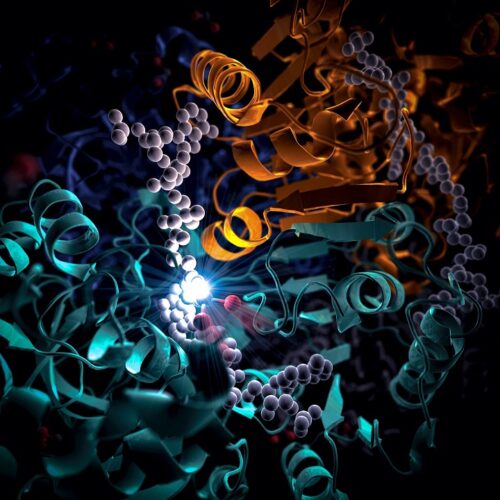How a Soil Microbe Could Rev Up Artificial Photosynthesis
04/05/2022

Artist interpretation of the enzyme enoyl-CoA carboxylase/reductase (ECR) from the bacterium Kitasatospora setae. The enzyme enables K. setae to fix carbon 20 times faster than plants do during photosynthesis. Researchers are looking for ways to harness and improve ECRs for artificial photosynthesis to produce fuels, antibiotics, and other products. [Image credit: SLAC National Accelerator Laboratory]
A team of researchers from DOE’s SLAC National Accelerator Laboratory and Joint Genome Institute, the Max Planck Institute for Terrestrial Microbiology in Germany, and the University of Concepción in Chile has discovered how a bacterial enzyme carries out a key step in carbon fixation 20 times faster than plant enzymes during photosynthesis. The findings provide a basis for engineering highly efficient CO2-fixing enzymes for bioenergy and bioproduct applications.
The team used a combination of ambient-temperature X-ray free electron laser (XFEL) and cryogenic synchrotron experiments to study the structural organization of enoyl-CoA carboxylase/reductase (ECR) from Kitasatospora setae. The approach revealed that rather than grabbing carbon dioxide molecules and attaching them to biomolecules one at a time, the ECR from K. setae consists of pairs of molecules that work in sync to get the job done faster. One member of each enzyme pair opens wide to catch a set of reaction ingredients while the other closes over its captured ingredients and carries out the carbon-fixing reaction; then, they switch roles in a continual cycle.
A single spot of molecular “glue” holds each pair together so they can alternate opening and closing in a coordinated way, while a twisting motion helps shuttle ingredients and finished products in and out of the pockets where the reactions take place. When both “glue” and “twist” are present, the carbon-fixing reaction proceeds 100 times faster than without them.
Related Links
- BER Resource: Structural Molecular Biology Resource
- Feature Story: How a soil microbe could rev up artificial photosynthesis
References
DeMirci, H., et al. 2022. Intersubunit coupling enables fast CO2-fixation by reductive carboxylases. ACS Cent. Sci. [DOI: 10.1021/acscentsci.2c00057]
